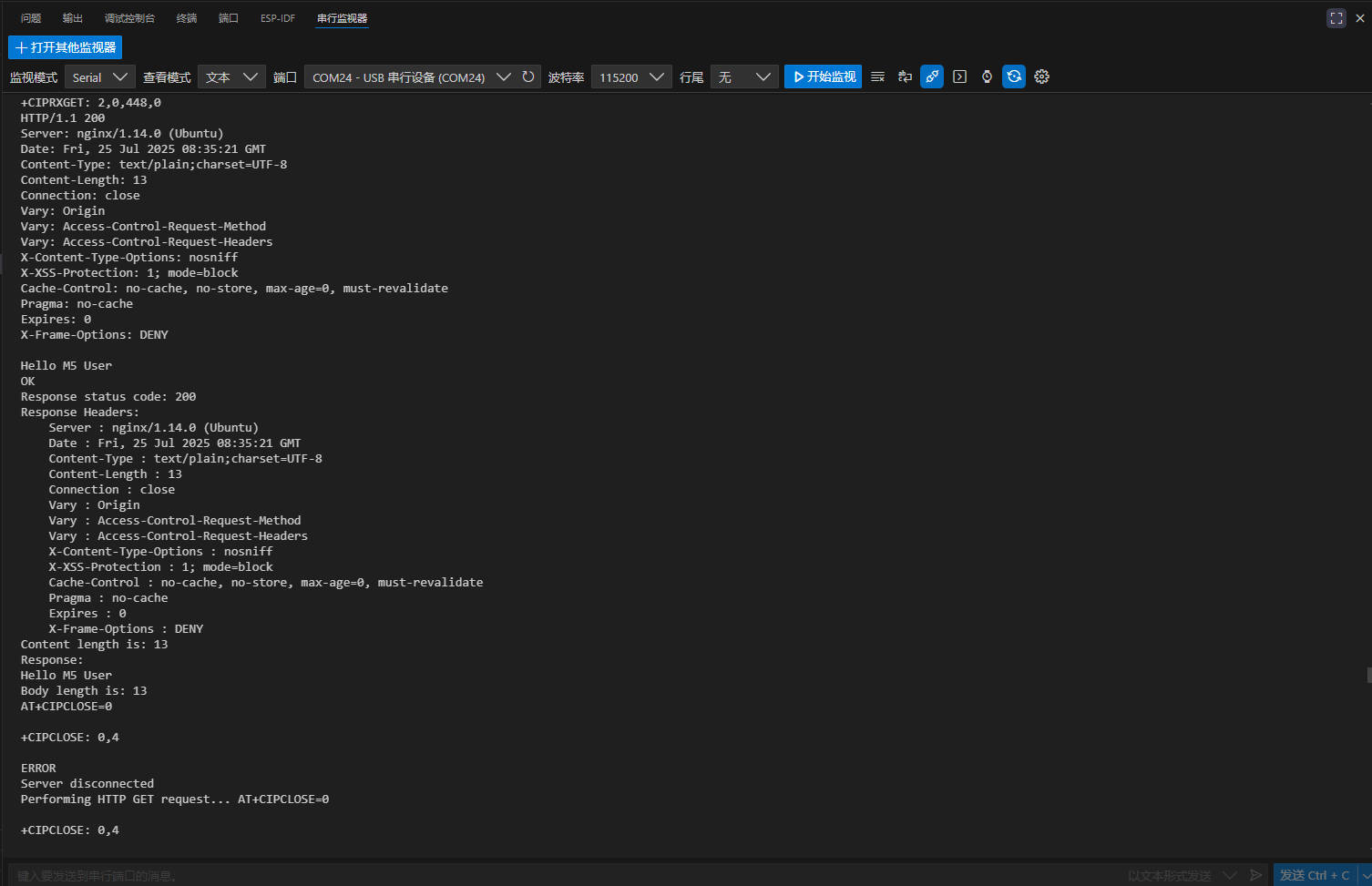Atom DTU NBIoT2 シリーズ Arduino チュートリアル
1. 準備作業
環境設定: Arduino IDE入門チュートリアルを参照し、IDE のインストールを完了し、使用する開発ボードに応じたボード管理と必要なドライバライブラリをインストールしてください。
使用するドライバライブラリ:
- 使用するハードウェア製品:


2. 注意事項

3. HTTP サービス
デフォルトでは SIM カードの CAT モードを使用します。NB-IoT モードに切り替えるには、TinyGsmClientSIM7028.h ファイル内の MODE_NB_IOT マクロ定義のコメントを解除してください。デバッグが必要な場合、TinyGsmClientSIM7028.h ファイル内の DUMP_AT_COMMANDS マクロ定義のコメントを解除できます。
#include "ATOM_DTU_NB.h"
#include <TinyGsmClient.h>
#include <M5AtomS3.h>
#include <sys/time.h>
#include <time.h>
#include <ArduinoHttpClient.h>
//#define MODE_NB_IOT // By default, CAT mode is used. If using NB-IOT
// mode, open this macro definition or TinyGsmClientSIM7028.h line 32 //#define
// MODE_NB_IOT
//#define DUMP_AT_COMMANDS // If you need to debug, you can open this macro
// definition and TinyGsmClientSIM7028.h line 13
// //#define TINY_GSM_DEBUG Serial
#ifdef DUMP_AT_COMMANDS
#include <StreamDebugger.h>
StreamDebugger debugger(SerialAT, SerialMon);
TinyGsm modem(debugger, ATOM_DTU_SIM7028_RESET);
#else
TinyGsm modem(SerialAT, ATOM_DTU_SIM7028_RESET);
#endif
// Server details
const char server[] = "api.m5stack.com";
const char resource[] = "/v1";
const int port = 80;
TinyGsmClient client(modem);
HttpClient http(client, server, port);
void modemConnect(void);
// Your GPRS credentials, if any
const char apn[] = "YourAPN";
const char gprsUser[] = "";
const char gprsPass[] = "";
struct tm now;
char s_time[50];
void log(String info) { SerialMon.println(info); }
void setup() {
AtomS3.begin(true); // Init M5AtomS3Lite.
AtomS3.dis.setBrightness(100);
AtomS3.dis.drawpix(0x0000ff);
Serial.println(">>ATOM DTU NB MQTT TEST");
SerialAT.begin(SIM7028_BAUDRATE, SERIAL_8N1, ATOM_DTU_SIM7028_RX,
ATOM_DTU_SIM7028_TX);
modemConnect();
}
void loop() {
AtomS3.update();
SerialMon.print(F("Performing HTTP GET request... "));
int err = http.get(resource);
if (err != 0) {
SerialMon.println(F("failed to connect"));
delay(10000);
return;
}
int status = http.responseStatusCode();
SerialMon.print(F("Response status code: "));
SerialMon.println(status);
if (!status) {
delay(10000);
return;
}
SerialMon.println(F("Response Headers:"));
while (http.headerAvailable()) {
String headerName = http.readHeaderName();
String headerValue = http.readHeaderValue();
SerialMon.println(" " + headerName + " : " + headerValue);
}
int length = http.contentLength();
if (length >= 0) {
SerialMon.print(F("Content length is: "));
SerialMon.println(length);
}
if (http.isResponseChunked()) {
SerialMon.println(F("The response is chunked"));
}
String body = http.responseBody();
SerialMon.println(F("Response:"));
SerialMon.println(body);
SerialMon.print(F("Body length is: "));
SerialMon.println(body.length());
// Shutdown
http.stop();
SerialMon.println(F("Server disconnected"));
}
void modemConnect(void) {
// Get card number
String ccid = modem.getSimCCID();
Serial.println("CCID: " + ccid);
// Acquire signal strength
int csq = modem.getSignalQuality();
Serial.println("Signal quality: " + String(csq));
unsigned long start = millis();
log("Initializing modem...");
while (!modem.init()) {
log("waiting...." + String((millis() - start) / 1000) + "s");
};
start = millis();
log("Waiting for network...");
while (!modem.waitForNetwork()) {
log("waiting...." + String((millis() - start) / 1000) + "s");
}
log("success");
#ifdef MODE_NB_IOT
#else
SerialMon.println("Waiting for GPRS connect...");
if (!modem.gprsConnect(apn, gprsUser, gprsPass)) {
SerialMon.println("waiting...." + String((millis() - start) / 1000) + "s");
}
SerialMon.println("success");
#endif
// Example Query the IP address of a device
String ip = modem.getLocalIP();
log("Device IP address: " + ip);
log("success");
}
HTTP リクエストが成功すると、サーバーからの一連の情報が返され、シリアルポートを通じて出力されます。

4. MQTT サービス
本モジュールは MQTT プロトコル通信もサポートしています。サンプルでは、Baidu Cloud 、 OneNET 、 ThingsCloud の 3 つの MQTT サービスプラットフォームに対応しています。このチュートリアルは Baidu Cloud IoT Platform を基にしています。他のプラットフォームを使用する場合は、 example フォルダ内の他のサンプルを参照してください。
SIM カードとデバッグモードの選択は HTTP と同じです。
MQTT_BROKER 、 mqtt_devid 、 mqtt_pubid 、 mqtt_password を個人の MQTT アカウント情報に置き換えてください。質問がある場合は、このチュートリアルを参照してください。
#include <M5AtomS3.h>
#include "ATOM_DTU_NB.h"
#include <PubSubClient.h>
#include <TinyGsmClient.h>
#include <time.h>
#include <sys/time.h>
#define MQTT_BROKER "*********" //Baidu Cloud address
#define MQTT_PORT 1883 //Port number
#define UPLOAD_INTERVAL 2000
#define mqtt_devid "*******" //Device ID
#define mqtt_pubid "*************" //username
#define mqtt_password "*************" //password
int postMsgId = 0; //Keep track of how many posts have been made
// This is the template used by post to upload data
#define ONENET_POST_BODY_FORMAT "{\"id\":%d,\"dp\":%s}"
// Receiving and sending properties set the subject
// Receive device properties to get the command topic
#define ONENET_TOPIC_GET "$iot/" mqtt_devid "/msg"
// Send data subject on the device
#define ONENET_TOPIC_POST "$iot/" mqtt_devid "/events"
int num=0;
uint32_t lastReconnectAttempt = 0;
#define DUMP_AT_COMMANDS //If you need to debug, you can open this macro definition and TinyGsmClientSIM7028.h line 13 //#define TINY_GSM_DEBUG Serial
#ifdef DUMP_AT_COMMANDS
#include <StreamDebugger.h>
StreamDebugger debugger(SerialAT, SerialMon);
TinyGsm modem(debugger, ATOM_DTU_SIM7028_RESET);
#else
TinyGsm modem(SerialAT, ATOM_DTU_SIM7028_RESET);
#endif
TinyGsmClient tcpClient(modem);
PubSubClient mqttClient(MQTT_BROKER, MQTT_PORT, tcpClient);
void mqttCallback(char *topic, byte *payload, unsigned int len);
bool mqttConnect(void);
void nbConnect(void);
void log(String info) {
SerialMon.println(info);
}
void setup() {
AtomS3.begin(true);
Serial.println(">>ATOM DTU NB MQTT TEST");
SerialAT.begin(SIM7028_BAUDRATE, SERIAL_8N1, ATOM_DTU_SIM7028_RX,
ATOM_DTU_SIM7028_TX);
AtomS3.dis.drawpix(0x0000ff);
nbConnect();
mqttClient.setServer(MQTT_BROKER, MQTT_PORT);
mqttClient.setCallback(mqttCallback);
}
void loop() {
static unsigned long timer = 0;
if (!mqttClient.connected()) {
log(">>MQTT NOT CONNECTED");
log(mqttClient.state());
AtomS3.dis.drawpix(0xff0000);
uint32_t t = millis();
if (t - lastReconnectAttempt > 10000L) {
lastReconnectAttempt = t;
if (mqttConnect()) {
lastReconnectAttempt = 0;
}
}
delay(100);
}
if (millis() >= timer) {
timer = millis() + UPLOAD_INTERVAL;
if (mqttClient.connected())
{
// First concatenate the json string
char param[120];
char jsonBuf[178];
sprintf(param, "{\"num\":[{\"v\":%d}]}",num); // We write the data to be uploaded in the param
postMsgId += 1;
num+=1;
if(num>256){
num=0;
}
sprintf(jsonBuf, ONENET_POST_BODY_FORMAT, postMsgId, param);
log("public the data:");
log(jsonBuf);
log("\n");
mqttClient.publish(ONENET_TOPIC_POST, jsonBuf);
//Send data to the topic
delay(100);
}
}
AtomS3.dis.drawpix(0x00ff00);
mqttClient.loop();
}
void mqttCallback(char *topic, byte *payload, unsigned int len) {
char info[len + 1];
memcpy(info, payload, len);
info[len] = '\0';
log("Message arrived:"+String(info));
log("Topic received: " + String(topic));
}
bool mqttConnect(void) {
log("Connecting to ");
log(MQTT_BROKER);
bool status =mqttClient.connect(mqtt_devid, mqtt_pubid, mqtt_password);
if (status == false) {
int errorCode = mqttClient.state();
log("MQTT Connection failed with error code: " + String(errorCode));
return false;
}
log("MQTT CONNECTED!");
mqttClient.subscribe(ONENET_TOPIC_GET);
return mqttClient.connected();
}
void nbConnect(void) {
unsigned long start = millis();
log("Initializing modem...");
while (!modem.init()) {
log("waiting...." + String((millis() - start) / 1000) + "s");
};
start = millis();
log("Waiting for network...");
while (!modem.waitForNetwork()) {
log("waiting...." + String((millis() - start) / 1000) + "s");
}
log("success");
String ccid = modem.getSimCCID();
Serial.println("CCID: " + ccid);
int csq = modem.getSignalQuality();
Serial.println("Signal quality: " + String(csq));
}
MQTT サービスが正常に接続されると、MQTT Explorer を使用してサブスクリプショントピックを追加し、データを確認できます。(質問がある場合は、このインターフェースを参照してください)

